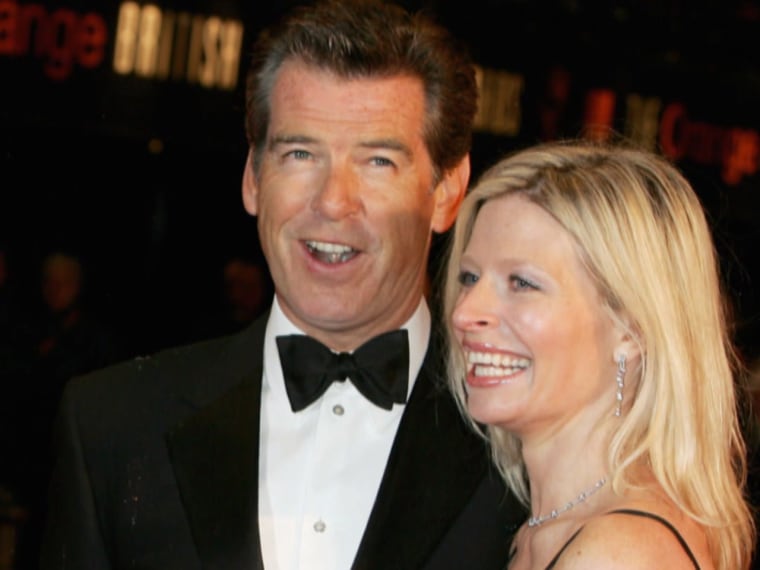Just as Angelina Jolie’s double mastectomy highlighted the risks of breast cancer among women with a genetic risk, the death of Pierce Brosnan’s daughter Charlotte last week at age 42 is shining a light on an even more deadly disease: ovarian cancer.
Ovarian cancer is often detected at a late stage, when it’s too late to treat effectively. While it’s not known whether Charlotte Brosnan was tested for the BRCA gene mutations that signal a high risk of breast and ovarian cancer, the fact that both her mother and her grandmother died young after developing the disease suggests that she had one of the mutations, experts say.
“The average age for women to develop ovarian cancer is in their 60s and 70s,” said Dr. Patricia Ganz, director of cancer prevention and control research at the Jonsson Comprehensive Cancer Center at the David Geffen School of Medicine at UCLA. “When you’ve got a very young age onset, it’s a red flag that it’s hereditary.”
Between 5 and 10 percent of ovarian cancers are hereditary, according to the National Cancer Institute. The most important risk factor is having one or more close relatives with the disease, the NCI notes.
Although ovarian cancer is more deadly, most attention has focused on women with BRCA mutations undergoing mastectomies to prevent breast cancer.
“That’s ironic, since the most useful thing you can do if you’re a BRCA-1 or -2 carrier is to have your ovaries removed,” said oncologist Dr. Susan Domchek, director of the Basser Research Center for BRCA, the only center in the nation devoted to research on prevention and treatment of cancers related to the genetic mutations.
“Oophorectomy is most strongly recommended because there is no effective screening for ovarian cancer and most present in late stages, in contrast to breast cancer where we have effective screening methods and most cancers are caught early.”
The hope is, Charlotte Brosnan’s death could bring more awareness to ovarian cancer risks and save lives in the process.
“Women are resistant to doing an oophorectomy because of the loss of estrogen and the impact on their quality of life,” said Dr. Robert Edwards, vice-chair of obstetrics and gynecology at the University of Pittsburgh Medical Center and co-director of the gynecologic oncology program at the Magee-Women’s Hospital at UPMC. “It’s curious that women choose to have mastectomy and to keep their ovaries, since ovarian cancer is much harder to screen for – and ovarian cancer is much more likely to be fatal.”
Another issue for women is child-bearing.
“There’s a tremendous pressure for these women to start their families earlier,” Edwards said. “It’s a tough situation to be in and there is a lot of denial. And while a lot of people know they’re at some risk, they don’t understand the degree and how deadly this cancer is.”
Experts suggest that women at high risk for the cancer have their ovaries removed between the ages of 35 and 40.
Some, like Domchek are hesitant to remove a woman’s ovaries before age 35 because the surgery thrusts women into menopause early, putting them at risk for a host of conditions, such as osteoporosis and heart disease.
Domchek points out that only 3 percent of ovarian cancers occur in women under age 40.
But when there’s a strong family history, Edwards suggests the surgery come even earlier. “If someone is done with child bearing, I recommend after age 30 and no later than age 35,” he said.
The good news for younger women who choose oophorectomy is that estrogen replacement can be safely taken if the woman has also had a hysterectomy, Domchek and Ganz said.
Another benefit from oophorectomy is that women are far less likely to develop breast cancer once their ovaries have been removed. So, some women are choosing to keep their breasts while removing their ovaries and tubes since oophorectomy reduces the breast cancer risk by 50 percent in those with BRCA mutations.
“With regular MRI screening most breast cancers can be picked up at an early stage,” Domchek said.
Another concern for women -- when ovarian cancer runs in families, the disease seems to strike earlier in subsequent generations, Ganz said. “Often the next generation down may have it occur 10 years earlier,” she added. “So maybe the grandmother got cancer in her 50s or 60s, and the next generation it showed up when a woman was in her 40s and in the next generation it could be in the 30s.”
In a statement, Pierce Brosnan said he hoped that researchers would find a cure for this “wretched disease.”
Until then, Domchek has a message for women at risk: “The one thing I really want to get out there is that Angelina Jolie may have had her breasts removed, but what women really need to worry about is their ovarian cancer risk – and have their ovaries removed.”
